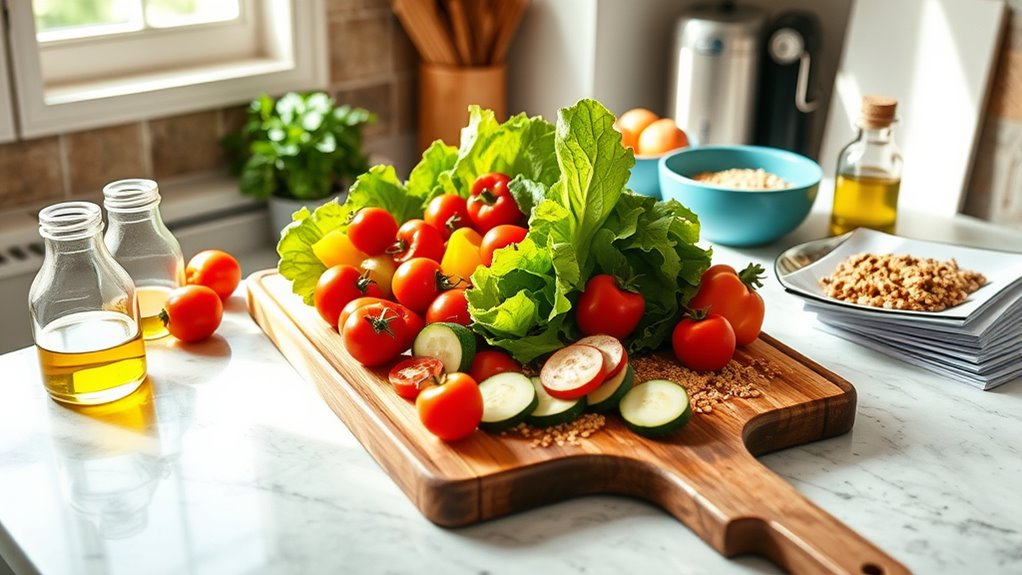Starting a flexitarian diet involves planning simple, nutrient-rich meals with plenty of vegetables, grains, and plant-based proteins, while occasionally including lean meats or seafood. Think ahead by creating a weekly shopping list focused on fresh produce, whole foods, and flexible ingredients. Batch prepping meals saves time and helps maintain variety. Building this routine gradually makes it easier to stay consistent and enjoy balanced eating. Keep exploring, and you’ll discover more tips to simplify your journey.
Key Takeaways
- Start by incorporating more plant-based meals with vegetables, grains, and legumes, gradually reducing meat consumption.
- Plan weekly menus and create detailed grocery lists focused on fresh, minimally processed foods.
- Batch cook simple recipes in advance to save time and ensure balanced, nutritious meals.
- Include moderate amounts of lean meats or seafood for variety, but prioritize plant-based proteins.
- Establish a flexible routine that adapts recipes and shopping to your preferences, promoting sustainable habits.

A flexitarian diet offers a flexible approach to eating that emphasizes plant-based foods while allowing occasional meat consumption. If you’re new to this way of eating, planning is key to making it manageable and enjoyable. One of the first steps is establishing a solid routine for meal prep. Preparing your meals ahead of time helps you stay on track and guarantees you’re getting a variety of nutrients without the daily stress of figuring out what to cook. Start by choosing simple recipes that focus on vegetables, legumes, grains, and lean proteins. Batch cooking large portions and storing them in containers makes it easy to grab healthy meals during busy days. This not only saves time but also reduces the temptation to opt for less nutritious fast food or takeout.
Grocery shopping is another critical aspect of flexitarian diet planning. When you go shopping, plan your meals for the week and make a detailed shopping list. Focus on buying fresh produce, whole grains, nuts, seeds, and plant-based protein sources like tofu or tempeh. Don’t forget to include some lean meats or seafood in moderation, which you can use to complement your plant-based meals. Shopping with a list helps you avoid impulse buys and keeps your diet balanced. It’s also helpful to explore the perimeter of the store, where fresh foods are usually located, rather than the aisles filled with processed snacks and packaged goods. This way, you stay true to your goal of emphasizing whole, minimally processed foods.
Incorporating meal prep and thoughtful grocery shopping into your routine can greatly ease your transition into a flexitarian lifestyle. As you become more familiar with your preferred ingredients and recipes, you’ll find it easier to plan ahead and shop efficiently. Keep your grocery list adaptable enough to accommodate seasonal produce and new ingredients you want to try. Over time, you’ll develop a personalized system that suits your tastes and schedule, making flexitarian eating sustainable and enjoyable. Remember, the goal is progress, not perfection. By taking small, consistent steps with meal prep and grocery shopping, you’ll build confidence and stay motivated to stick with your new eating habits. With preparation and mindful shopping, you’ll find it easier to enjoy a balanced, nourishing diet that fits your lifestyle.
Frequently Asked Questions
Can a Flexitarian Diet Support Athletic Performance?
Yes, a flexitarian diet can support athletic performance. You’ll benefit from adequate protein intake by including plant-based and lean animal sources, which helps muscle repair and growth. Paying attention to meal timing guarantees you fuel your workouts and recover properly. This balanced approach provides energy, supports recovery, and maintains overall health, making it a versatile choice for athletes looking to optimize performance without strict restrictions.
How Does Flexitarianism Impact Environmental Sustainability?
Have you ever wondered how your food choices affect the planet? Flexitarianism promotes sustainable farming by reducing meat consumption, which in turn helps lower greenhouse gas emissions. By choosing more plant-based meals, you support reduced carbon footprints and conserve resources. Isn’t it rewarding to make simple changes that benefit the environment? Embracing a flexitarian diet encourages eco-friendly habits, making it easier to contribute to a healthier, more sustainable world.
Are There Specific Supplements Recommended for Flexitarians?
You might wonder if you need supplements on a flexitarian diet. While focusing on plant-based supplements can help fill nutrient gaps, you should consider nutrient considerations like vitamin B12, iron, omega-3s, and vitamin D. If your intake of these nutrients is low from food sources, taking targeted supplements can support your health. Always consult a healthcare professional to personalize your supplement plan and make certain you’re meeting your nutritional needs.
How to Handle Social Situations While on a Flexitarian Diet?
You might think social dining is tricky on a flexitarian diet, but it’s manageable. Visualize it like event planning—choose restaurants with flexible menus or call ahead to guarantee veggie options are available. When dining out, suggest sharing dishes or bringing a plant-based dish to contribute. By planning ahead and communicating your preferences, you stay flexible and enjoy social occasions without stress or sacrificing your diet goals.
Is a Flexitarian Diet Suitable for Children and Pregnant Women?
You might wonder if a flexitarian diet suits children and pregnant women. It can support child nutrition and pregnancy safety when planned properly. You should include a variety of nutrient-rich foods like fruits, vegetables, lean proteins, and whole grains. Always consult healthcare providers to ensure specific needs are met. This way, you promote healthy growth and development while enjoying the versatility of a flexitarian approach.
Conclusion
Now that you’re diving into the flexitarian lifestyle, you’re about to open the secret to eating smarter, feeling better, and saving the planet—all at once! Imagine transforming your meals into powerful, delicious, planet-loving masterpieces every single day. With just a little planning, you’ll become a culinary superhero, conquering cravings and boosting your energy like never before. So go ahead, embrace the flexitarian way—your taste buds and the world will thank you forever!









